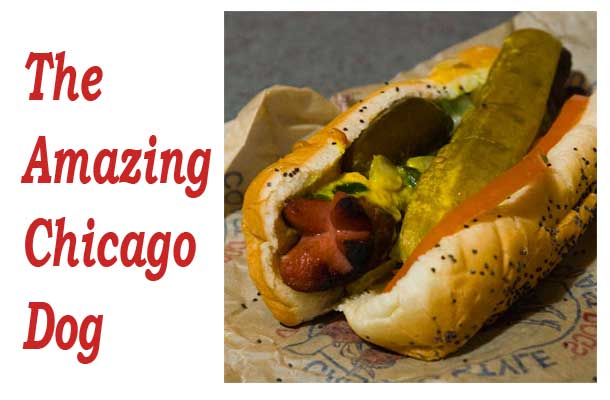“It’s 106 miles to Chicago, we got a full tank of gas, half a pack of cigarettes, it’s dark, and we’re wearing sunglasses.” Elwood Blues (Dan Akroyd)
CHICAGO –In Chicago, where hot dog stands far out number hamburger joints, there is one and only one classic recipe, and very little variation from it. It is the perfect hot dog.
Ask foodies around the world what makes the great city in the middle of America famous and they will reply Charlie Trotter’s, Topolobampo, Everest, or one of the other temples of the table. Ask tourists what culinary wonder starts them salivating and they’ll say deep dish pizza. But ask the “Grabowskis” as Da Coach Mike Ditka calls hard working lunch pail Chicagoans, and they will tell you it is the Chicago Hot Dog.
Here’s proof. In 2005, The Chicago Tribune polled its readers to determine the “7 Wonders of Chicago.” Predictably the top 10 were the magnificent Lake Michigan lakefront, Wrigley Field, the “El” elevated trains, the Sears Tower, the 1869 Water Tower, the University of Chicago, the Museum of Science and Industry, the Chicago River, Millennium Park, and Chicago Blues. In 11th place was the Chicago Hot Dog. Pizza didn’t even make the list. The Chicago Hot Dog is so popular the newspaper estimates there are 1,800 hot dog stands in the area, far more than all the McDonald’s, Burger Kings, and Wendy’s combined. To see my favorite Chicago Hot Dog stands, click here.
What makes the Chicago Hot Dog special? Like Chicago’s famous architecture, it is great design. It is a juicy, crunchy, sloppy combo that leaves your fingers fragrant for hours: A garlicy all-beef frankfurter, usually Vienna Beef brand, with a natural casing, simmered in hot water, never boiled, on a Rosen’s bun studded with poppy seeds and topped with solar yellow mustard, sweet kryptonite green pickle relish, pungent chopped onion, juicy tomato slices, spicy hot “sport” peppers, a salty crunchy kosher pickle spear, and a sprinkle of magic dust: celery salt. The result is a sandwich with so much vegetation that it is called a “garden on a bun”. This is the recipe that is served at practically all hot dog stands in Chicago.
It makes sense. In the 1800s meat packers such as Armour, Swift, and Oscar Mayer grew up on the Southside. There were enough slaughterhouses that Chicago was dubbed “hog butcher for the world” by poet laureate Carl Sandburg. At the same time, Chicago is built on such rich black soil that if you spit on it a human being will sprout, hence the city’s official motto “Urbs in Horto”, City in a Garden.
Many of the immigrants who settled in Chicago and worked in the stockyards were farmers back home and they planted vegetable gardens behind their homes in Chicago. The Chicago Hot Dog was the inevitable confluence of flesh and verdure. Perhaps the city’s motto should be changed to “Hortus in Pane.”
Nobody knows for sure where the recipe started, but here’s one credible story: Located in the great outdoor Jewish Maxwell Street Market, Fluky’s was opened on the northwest corner of Maxwell and Halsted about the same time the stock market crashed in 1929 by Abe “Fluky” Drexler when he was only 18 years old. The rickety wooden shack with no refrigeration and a fire hydrant for water became known for its “Depression Sandwich,” a complete meal for the laborer, a hot dog with mustard, relish, onion, pickles, pepper, lettuce, tomatoes, and fries for only a nickel.
The customary method for cooking dogs in Chicago is called the “dirty water” method. The dogs are simmered, not boiled, in water for 10 minutes. This makes them turgid and juicy, firm but not rubbery. After simmering scores of dogs in the same water all day the water is rich in flavor. The goal is to cook the meat through without cracking the skins.
Another technique is to steam them for 15 minutes. Steaming leaves the meat more piquant than simmering, with a nice snappy skin.
Some vendors roll them around on a hot dog rotisserie, hot stainless steel tubes that keep the dog rolling in its sleep on a perpetual motion conveyor belt to gustatory perfection. This makes a tastier dog than simmering or steaming, with a crisper skin, but they are not as moist and puffy. The problem is that sometimes they sit on these rollers all day and precious fluids begin to drip off.
Personally, I am among the minority who prefer what the locals call “char dogs,” cooked over an open flame, to the dirty water dog. The dry heat keeps them crisp and keeps all the juices inside where they belong. It also browns the skins creating sweetness that chefs call “caramelization” or the “Maillard reaction.” This also amps up the garlic and paprika. They don’t plump up as much and they are a bit less juicy, but the added richness stands up better to all the condiments we pile onto a hot dog in Chicago. Voicing such a preference will guarantee that I am ostracized by the purists in Chicago. So be it.
Yield. 1 serving
Preparation time. 10 minutes
Cooking time. 10 minutes
Assembly time. 2 minutes
Recipe: The Chicago Hot Dog
Ingredients
1 bun length jumbo all beef frankfurter with a natural casing
1 poppy seed bun
1 long squirt of yellow mustard
2 tablespoons sweet pickle relish
2 tablespoons onion, coarsely chopped fine
1/4 medium Roma tomatoes
2 pickled sport peppers
1 kosher pickle spear or fresh cucumber spear, about 5″ long
1/4 teaspoon celery salt
The frank. In Chicago, all beef hot dogs with natural beef casings are compulsory. No pork, no turkey, no chicken. No crap. Snap and squirt are the hallmarks of a good Chicago Hot Dog, and the snap comes from the casings and the toppings. Skinless hot dogs are best saved for infants and the toothless. Vienna Beef is the preferred brand.
The bun. Rosen’s is the preferrred brand. Poppy seeds contribute a slightly nutty taste to the bun. These tiny blue-gray seeds come from an opium plant and they contain miniscule amounts of morphine and codeine. Not to fear, you would probably have to eat more than a dozen buns to lose your job.
The mustard. There are many different types of mustard, but the classic Chicago Hot Dog is made with yellow “ballpark” mustard. Most of them are made by grinding the seeds from white mustard plants and mixing the powder with vinegar, water, and spices.
The relish. In Chicago the pickle relish is brilliant kryptonite green. Sweet and tart, pickle relishes are typically made from chopped cucumbers, bell peppers, green tomatoes, onions, distilled vinegar, and sugar. For the kryptonite green stuff, Blue No. 1 food coloring is added. If you can’t find it, and outside of Chicago it is pretty scarce, regular old olive drab pickle relish will do just fine.
The peppers. Skinny and about 1-2″ long, pickled sport peppers are made by pickling fresh green Capsicum annuum, a cultivar of the Tabasco pepper. They are cured in vinegar and a spiced brine. They are moderately hot but not too hot for wusses like me, and they allow Chicago Hot Dogs to bite you back. Yes, even if you are a feeb, you must have sports for it to be an authentic Chicago Hot Dog. But don’t use too hot a pepper. Remember, the Chicago Hot Dog is all about balancing flavors.
The pickle. A kosher pickle spear is common, but the best Chicago Hot Dogs, IMHO, use crunchier new pickles. Try Chipco brand from The Chicago Pickle Company. Kosher pickles are made from a special breed of cucumber fermented in a brine, a bath of salt, garlic, black pepper, dill, and vinegar. They are Kosher when they are made in adherence with Jewish dietary law under the supervision of a rabbi. Kosher pickles are never sweet. If you can get fresh whole pickles from a barrel, spears are about 1/8 of a pickle. One of my favorite hot dog carts, Mary Ann’s, uses fresh cucumber spears, skin removed, instead of pickles. It may border on heresy, but I love it.
The onions. White Spanish onions are typically used because they are both sweet and pungent. They must be chopped fresh or else they get acidic, stinky, and lose their sweetness.
The tomatoes. Most hot dog stands use regular round slicing tomatoes cut into two wedge shapes or slices, but I think fresh pear-shaped Roma tomatoes are best because they are meatier and not as runny. I like to dice the tomatoes into 1/4″ chunks so each mouthful has tomato in it. Restaurants can’t do this because diced tomatoes lose their juice when sitting around. And for goodness sake, when you make hot dogs at home, use ripe tomatoes. Alas, while researching this story, even in August, most hot dog stands used pink rocks rather than real tomatoes.
Method
1) For the Classic Dirty Water Dog: Bring enough water to cover the dog to a boil, then cut back to a simmer. Simmer, never boil, the dog for 10 minutes.
For a Char Dog: This is a technique I learned from Gold Coast Dogs. Cut an X shape in the ends of the dog. When they cook they will curl up and get extra crispy (see photo at right). Cook the dogs over a medium high grill until the skin darkens and there are nice grill marks all around.
2) Traditional Chicago Hot Dog buns are steamed. Click here for tips on how to prepare your buns.
3) Cut the stem off the end of the tomato and squeeze it over the trash can ejecting the seeds. Chop the tomato into 1/4″ chunks.
4) Place the frankfurter on the bun. Squirt the mustard on the dog on one side between the meat and the bun. Spread the relish between the meat and the bun on the opposite side of the mustard. Sprinkle the chopped onions on top of the mustard. Distribute the tomato chunks all around. Place the peppers on top of the tomatoes. Place the spear on top of the onions and mustard. Sprinkle the celery salt on top of the vegetation.
5) Absolutely, positively, no ketchup. Fohgeddaboudit.









